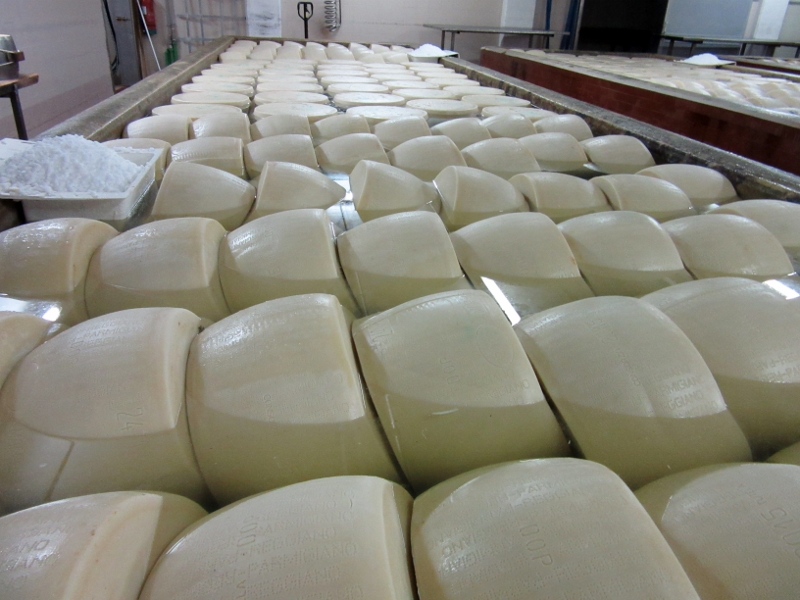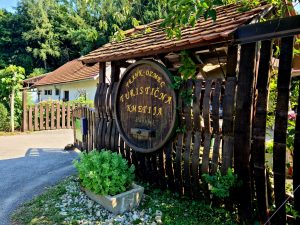I lived with a chap once who would throw up at the smell of Parmesan cheese. He hated the smell. Absolutely detested it. And this was back in a day and a place where Parmesan cheese came out of a shaker, already grated. Every time I smell it, I think of him. Weird.
De Wimmen told me once that France would be wasted on me as I didn’t drink wine, eat olives, or appreciate cheese. I’ve grown up a lot since then.
But for years, Parmesan was something I added to stuff – to pizzas, pastas, salads. It was never one of those cheeses I ate chunks of. But in Milan last year, an Italian friend introduced me to the joy that is real, aged, Parmesan, and I was converted. So much so that when I was in Parma (after seeing the Parma ham production facility) I tagged along on a study tour of a Parmesan cheese facility, one of 161 in the region.
Did you know that Parmesan cheese is only made in the morning? Milk is collected from the farms twice a day from cows who are fed an all-natural diet of grass and hay. Nothing else. [Oops… doesn’t that mean they’re locked up all the time? Or muzzled? Not good.] The evening milk is collected in the evening and left to sit overnight to let the cream rise to the top. The next morning, when the morning milk arrives, it’s added to the now-skimmed milk from the previous evening. (It takes 16 litres of milk to make 1kg of cheese.)
Some fermented whey is added to the new mix as it is heated in massive cauldron and starts to acidify it. To this is added rennet (an enzyme that comes from the stomach of a milk-fed calf or goat – who knew?). Rennet coagulates the milk and so it begins to curd.
Now, imagine the whisk in your kitchen on steroids and you might come close imagining to the massive one that cheese makers call a spino, which they use to break up the large clumps of curd into much smaller pieces. All the while, the milk is still cooking. When it gets to a certain temperature, the heat is removed and after an hour or so all the little curds sink to the bottom – and so the cheese begins to form.
This goo is removed from the liquid using a wooden paddle and wrapped in muslin in the shape of a large wheel [I suspect I missed a step and the goo is actually put into stainless steel moulds – which I saw lying around – but I wouldn’t swear to it. Our guide had a fab handbag draped over her arm and I was a little distracted.] There is enough in each cauldron to make two wheels so they’re rather appropriately, if oddly, called twins. The twins are then literally hung out to dry – to rid themselves of excess liquid. What’s left in the cauldrons (whey) is used for the next day’s cheese and what’s not needed goes to feed the local pigs, which will soon end up as Parma ham. There’s a certain holistic something to that, don’t you think?
When a lot of the excess liquid has dripped away, the wheels are moved into round wooden forms and branded with date of birth, origin, etc. (I love this traceability stuff.) They’re turned a few times as the liquid continues to drain and the cheese is still soft. A piece of plastic with the words Parmigiano Reggianno is slotted between the cheese and the edge of the wooden frame and thus the cheese is branded – name, date and serial number. Oh if only they could talk.

I never knew that you could invest in cheese wheels. Buy a load of them and wait 12 months in the hope that the price goes up. You rent the space at an ageing facility and sit it out. I bought some at the facility for €13/kg. At the airport it retailed at€35. Same bloody cheese. Perhaps it’s worth looking into.
PS. Lactose intolerant? Apparently if the Parmigiano Reggianno is older than 30 months, you’re good to go. It’s safe to eat.
PPS. Cheese = milk, whey, rennet. Therefore ricotta is not a cheese. Amazing what you learn.
Share this:
- Click to share on X (Opens in new window) X
- Click to share on Facebook (Opens in new window) Facebook
- Click to share on Pinterest (Opens in new window) Pinterest
- Click to share on LinkedIn (Opens in new window) LinkedIn
- Click to share on Reddit (Opens in new window) Reddit
- Click to share on WhatsApp (Opens in new window) WhatsApp
- Click to share on Pocket (Opens in new window) Pocket
- Click to share on Telegram (Opens in new window) Telegram
- Click to email a link to a friend (Opens in new window) Email














4 responses
Fascinating and fabulous. Given the chance, I eat it, not grate it, delicious.
Again, excellent writing of linking a global product to its local roots and production knowledge! Thanks to the Consorzio del Parmigiiano Reggiano for helping out the Organisers fo the 145th EAAE Seminar setting up this visit! We are happy you enjoyed the experience and put the knowledge you gained into words for the others to benefit from!
Thanks Mario – hope you caught the piece in the Budapest Times the week after the event.